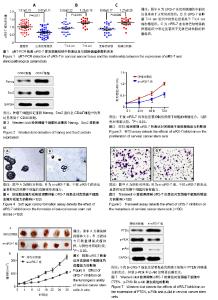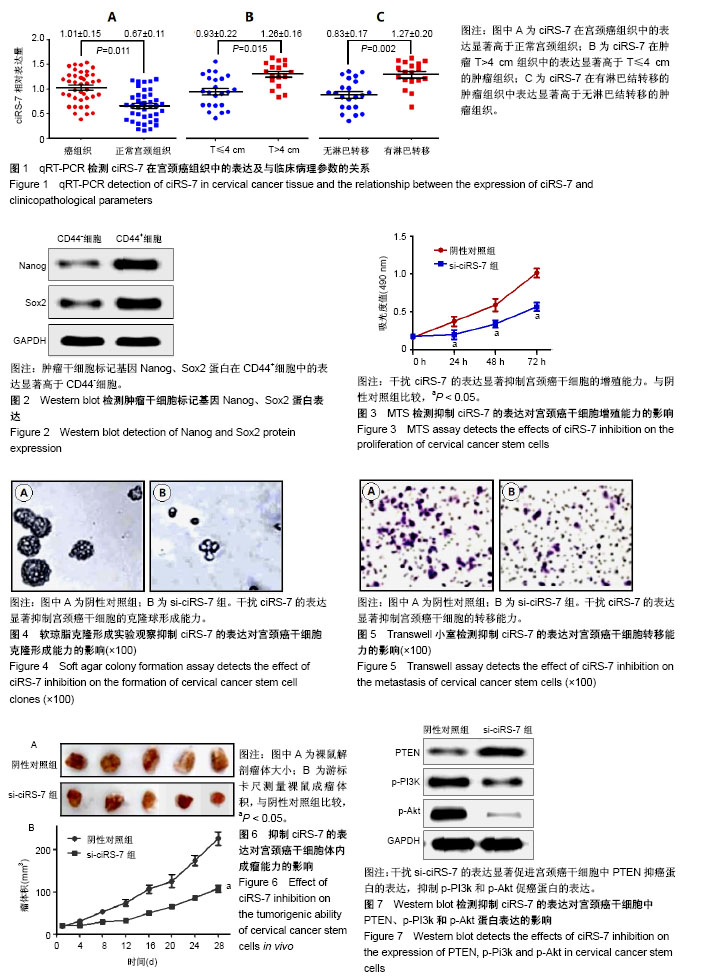| [1] Wardak S. Human Papillomavirus (HPV) and cervical cancer. Med Dosw Mikrobiol. 2016;68(1):73-84.[2] Mezei AK, Armstrong HL, Pedersen HN, et al. Cost-effectiveness of cervical cancer screening methods in low- and middle-income countries: A systematic review. Int J Cancer. 2017;141(3):437-446.[3] Siegel RL, Miller KD, Jemal A. Cancer statistics, 2018. CA Cancer J Clin. 2018;68(1):7-30.[4] 颜涛,王枭雄,王春雷,等.肿瘤干细胞及肿瘤可塑性和异质性的研究进展[J].中国微侵袭神经外科杂志,2017,22(3):142-144.[5] Tomiyama N, Ikeda R, Nishizawa Y, et al. S100A16 up-regulates Oct4 and Nanog expression in cancer stem-like cells of Yumoto human cervical carcinoma cells. Oncol Lett. 2018;15(6):9929-9933.[6] Gong P, Hu C, Zhou X, et al. TAT-mediated si-hWAPL inhibits the invasion and metastasis of cervical cancer stem cells. Exp Ther Med. 2017;14(6):5452-5458. [7] Ma HB, Yao YN, Yu JJ, et al. Extensive profiling of circular RNAs and the potential regulatory role of circRNA-000284 in cell proliferation and invasion of cervical cancer via sponging miR-506. Am J Transl Res. 2018;10(2):592-604.[8] Zhang J, Zhao X, Zhang J, et al. Circular RNA hsa_circ_ 0023404 exerts an oncogenic role in cervical cancer through regulating miR-136/TFCP2/YAP pathway. Biochem Biophys Res Commun. 2018;501(2):428-433.[9] Li RC, Ke S, Meng FK, et al. CiRS-7 promotes growth and metastasis of esophageal squamous cell carcinoma via regulation of miR-7/HOXB13. Cell Death Dis. 2018;9(8):838.[10] Zhang X, Yang D, Wei Y. Overexpressed CDR1as functions as an oncogene to promote the tumor progression via miR-7 in non-small-cell lung cancer. Onco Targets Ther. 2018;11: 3979-3987.[11] Chen W, Zheng R, Baade PD, et al. Cancer statistics in China, 2015. CA Cancer J Clin. 2016;66(2):115-132.[12] Suneja G, Brown D, Chang A, et al. American Brachytherapy Society: Brachytherapy treatment recommendations for locally advanced cervix cancer for low-income and middle-income countries. Brachytherapy. 2017;16(1):85-94.[13] Shrestha AD, Neupane D, Vedsted P, et al. Cervical Cancer Prevalence, Incidence and Mortality in Low and Middle Income Countries: A Systematic Review. Asian Pac J Cancer Prev. 2018;19(2):319-324.[14] Ladouceur A, Bernatsky S, Ramsey-Goldman R, et al. Managing cancer risk in patients with systemic lupus erythematous. Expert Rev Clin Immunol. 2018;14(10):793-802.[15] Chaffer CL, Weinberg RA. A perspective on cancer cell metastasis. Science. 2011;331(6024):1559-1564.[16] Xiao JB, Li XL, Liu L, et al. The association of semaphorin 5A with lymph node metastasis and adverse prognosis in cervical cancer. Cancer Cell Int. 2018;18:87.[17] Liu M, Tu J, Gingold JA, et al. Cancer in a dish: progress using stem cells as a platform for cancer research. Am J Cancer Res. 2018;8(6):944-954. [18] Hsu MT, Coca-Prados M. Electron microscopic evidence for the circular form of RNA in the cytoplasm of eukaryotic cells. Nature.1979;280(5720):339-340.[19] Lux S, Bullinger L. Circular RNAs in Cancer. Adv Exp Med Biol. 2018;1087:215-230.[20] Holdt LM, Stahringer A, Sass K, et al. Circular non-coding RNA ANRIL modulates ribosomal RNA maturation and atherosclerosis in humans. Nat Commun. 2016;7:12429.[21] Zheng Q, Bao C, Guo W, et al. Circular RNA profiling reveals an abundant circHIPK3 that regulates cell growth by sponging multiple miRNAs. Nat Commun. 2016;7:11215.[22] Liu J, Wang D, Long Z, et al. CircRNA8924 Promotes Cervical Cancer Cell Proliferation, Migration and Invasion by Competitively Binding to MiR-518d-5p /519-5p Family and Modulating the Expression of CBX8. Cell Physiol Biochem. 2018;48(1):173-184.[23] Wang F, Wang J, Cao X, et al. Hsa_circ_0014717 is downregulated in colorectal cancer and inhibits tumor growth by promoting p16 expression. Biomed Pharmacother. 2018; 98:775-782.[24] Wu Y, Zhang Y, Niu M, et al. Whole-Transcriptome Analysis of CD133+CD144+ Cancer Stem Cells Derived from Human Laryngeal Squamous Cell Carcinoma Cells. Cell Physiol Biochem. 2018;47(4):1696-1710.[25] Xiao T, Xue J , Shi M, et al. Circ008913, via miR-889 regulation of DAB2IP/ZEB1, is involved in the arsenite-induced acquisition of CSC-like properties by human keratinocytes in carcinogenesis. Metallomics. 2018;10(9):1328-1338.[26] Sang M, Meng L, Liu S, et al. Circular RNA ciRS-7 Maintains Metastatic Phenotypes as a ceRNA of miR-1299 to Target MMPs. Mol Cancer Res. 2018;16(11):1665-1675.[27] Huang H, Wei L, Qin T, et al. Circular RNA ciRS-7 triggers the migration and invasion of esophageal squamous cell carcinoma via miR-7/KLF4 and NF-κB signals. Cancer Biol Ther. 2019;20(1):73-80.[28] 尹彦斌,王建杰,刘祎,等.肿瘤干细胞分离研究进展[J].现代生物医学进展,2016,16(2):382-385.[29] Liu H, Wang YJ, Bian L, et al. CD44+/CD24+ cervical cancer cells resist radiotherapy and exhibit properties of cancer stem cells. Eur Rev Med Pharmacol Sci. 2016;20(9):1745-1754.[30] 曹群,杨炳.宫颈癌干细胞相关研究进展[J].贵州医药, 2016,40(4): 429-431. [31] He JH, Li YG, Han ZP, et al. The CircRNA-ACAP2/Hsa-miR-21-5p/ Tiam1 Regulatory Feedback Circuit Affects the Proliferation, Migration, and Invasion of Colon Cancer SW480 Cells. Cell Physiol Biochem. 2018; 49(4):1539-1550.[32] Su C, Han Y, Zhang H, et al. CiRS-7 targeting miR-7 modulates the progression of non-small cell lung cancer in a manner dependent on NF-κB signalling. J Cell Mol Med. 2018;22(6): 3097-3107.[33] 孙连碧,李广海,曹东华.miR-7靶向调节EGFR基因对卵巢癌SKOV3细胞增殖和侵袭的影响[J].解剖科学进展, 2017,23(4): 360-362,366.[34] Qin AD, Liu XX, Li J, et al. The effects of microRNA-7 on proliferation and invasion of hepatocellular carcinoma HepG2 cells. Zhonghua Zhong Liu Za Zhi. 2018;40(6):406-411.[35] Hao Z, Yang J, Wang C, et al. MicroRNA-7 inhibits metastasis and invasion through targeting focal adhesion kinase in cervical cancer. Int J Clin Exp Med. 2015;8(1):480-487.[36] Pan H, Li T, Jiang Y, et al. Overexpression of Circular RNA ciRS-7 Abrogates the Tumor Suppressive Effect of miR-7 on Gastric Cancer via PTEN/PI3K/AKT Signaling Pathway. J Cell Biochem. 2018;119(1):440-446.[37] Feng X, Jiang J, Shi S, et al. Knockdown of miR-25 increases the sensitivity of liver cancer stem cells to TRAIL-induced apoptosis via PTEN/PI3K/Akt/Bad signaling pathway. Int J Oncol. 2016;49(6):2600-2610. |

